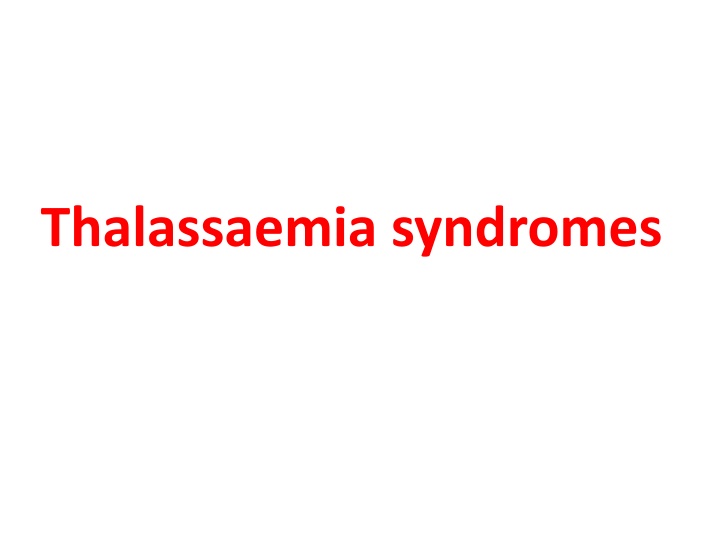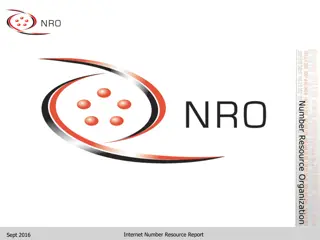
Thalassaemia Syndromes Treatment and Management Guidance
Learn about the comprehensive treatment approach for thalassaemia syndromes, including regular blood transfusions, iron chelation therapy, use of oral chelators, supplementation, splenectomy considerations, endocrine therapy, and immunization against hepatitis B. Effective management strategies are crucial in maintaining optimal health for individuals with thalassaemia.
Download Presentation

Please find below an Image/Link to download the presentation.
The content on the website is provided AS IS for your information and personal use only. It may not be sold, licensed, or shared on other websites without obtaining consent from the author. If you encounter any issues during the download, it is possible that the publisher has removed the file from their server.
You are allowed to download the files provided on this website for personal or commercial use, subject to the condition that they are used lawfully. All files are the property of their respective owners.
The content on the website is provided AS IS for your information and personal use only. It may not be sold, licensed, or shared on other websites without obtaining consent from the author.
E N D
Presentation Transcript
Treatment 1 Regular blood transfusions are needed to maintainthe haemoglobin over 10 g/dL at all times. This usually requires 2-3 units every 4-6 weeks Fresh blood, filtered to remove white cells, gives the best red cell survival with the fewest reactions. The patients should be genotyped at the start of the transfusion program in case red cell antibodies against transfused red cells develop.
2- Regular folic acid (e.g. 5 mg/day) is given if the diet is poor. 3 -Iron chelation therapy is used to treat iron overload. The most established drug, deferoxamine, is inactive orally. It may be given by a separate infusion bag 1-2 g with each unit of blood transfused and by subcutaneous infusion 40 mg/kg over 8-12 h, 5-7 days weekly. It is commenced in infants after 10-15 units of blood have been transfused.
Deferiprone is an orally active iron chelator which causes predominantly urine iron excretion. It is usually given in three doses daily . more effective than deferoxamine at removing cardiac iron
Deferasirox is the newest oral chelator. It is given once daily and causes faecal iron excretion only. Skin rashes and transient changes in liver enzymes have been reported. The ease of administration and its lack of major side-effects are likely to result in its widespread use.
4- Vitamin C, 200 mg/day, increases excretion of iron produced by deferoxamine. 5 -Splenectomy may be needed to reduce blood requirements. This should be delayed until the patient is over 6 years old because of the high risk of dangerous infections post-splenectomy. vaccinations and antibiotics should be given
6- Endocrine therapy is given either as replacement because of end-organ failure or to stimulate the pituitary if puberty is delayed. Diabetics will require insulin therapy. Patients with osteoporosis may need additional therapy with increased calcium and vitamin D in their diet, together with a bisphosphonate and appropriate endocrine therapy.
7 -Immunization against hepatitis B should be carried out in all non-immune patients. Treatment for transfusion-transmitted hepatitis C with alpha interferon and ribavirin is needed if viral genomes are detected in plasma.
8- Allogeneic bone marrow transplantation offers the prospect of permanent cure. The success rate(long-term thalassaemia major-free survival) is over 80% in well-chelated younger patients without liver fibrosis or hepatomegaly. A human leucocyte antigen (HLA) matching sibling (or rarely other family member or matching unrelated donor) acts as donor. Failure is mainly a result of recurrence of thalassaemia, death (e.g. from infection) or severe chronic graft-versus-host disease
Beta Thalassaemia trait (minor) This is a common, usually symptomless, abnormality characterized like alpha-thalassaemia trait by a hypochromic, microcytic blood picture (MCV and MCH very low) but high red cell count (>5.5 x 1012/L) and mild anaemia (haemoglobin 10-12.g/dL). It is usually more severe thanalpha trait. A raised Hb A2 (>3.5%) confirms the diagnosis. One of the most important indications for making the diagnosis is that it allows the possibility of prenatal counselling to patients with a partner who also has a significant haemoglobin disorder. If both carry beta thalassaemia trait there is a 25% risk of a thalassaemia major child
Thalassaemia intermedia Cases of thalassaemia of moderate severity (haemoglobin 7.0- 10.0 g/dL) who do not need regular transfusions are called thalassaemia intermedia This is a clinicnl syndrome which may be caused by a variety of genetic defects: homozygous beta-thalassaemia with production of more Hb F than usual or with mild defects in beta-chain synthesis, by beta-thalassaemia trait alone of unusual severity ('dominant' beta-thalassaemia)or beta-thalassaemia trait in association with mild globin abnormalities suchas Hb Lepore. .
The coexistence of alpha-thalassaemia trait improves the haemoglobin level in homozygous beta-thalassaemia by reducing the degree of chain imbalance and thus of alpha-chain precipitation and ineffective Erythropoiesis Conversely, patient with beta thalassaemia trait who also have excess (five or six) a genes tend to be more anaemic than usual.
The patient with thalassaemia intermedia may show bone deformity, enlarged liver and spleen, extramedullary erythropoiesis and features of iron overload caused by increased iron absorption. Hb H disease (three-gene deletion alpha- thalassaemia) is a type of thalassaemia intermedia without iron overload or extramedullary haemopoiesis.
Thalassaemia intermedia. Homozygous beta-thalassaemia Homozygous mild +-thalassaemia Coinheritance of alpha thalassaemia Enhanced ability to make fetal haemoglobin ( -chain production) Heterozygous beta-thalassaemia Coinheritance of additional alpha-globin genes ( / ) or ( / ) Dominant beta-thalassaemia trait - Thalassaemia and hereditary persistence of fetal haemoglobin Homozygous thalassaemia Heterozygous thalassaemia/beta-thalassaemia Homozygous Hb Lepore (some cases) Haemoglobin H disease
-Thalassaemia This involves failure of production of both and chains. in the heterozygous state Fetal haemoglobin production is increased to 5-20% which resembles thalassaemia minor haematologically. In the homozygous state only Hb F is present and haematologically the picture is of thalassaemia intermedia.
Haemoglobin Lepore This is an abnormal haemoglobin caused by unequal crossing-over of the beta and delta genes to produce: a polypeptide chain consisting of the delta chain at its amino end and beta chain at its carboxyl end. The -fusion chain is synthesized inefficiently and normal delta- and beta-chain production is abolished. The homozygotes show thalassaemia intermedia and the heterozygotes thalassaemia trait.
Hereditary persistence of fetal haemoglobin These are a heterogeneous group of genetic conditions caused by: deletions or cross-overs affecting the production of and chains or, in non-deletion forms, by point mutations upstream from the globin genes.
Association of beta-thalassaemia trait with other genetic disorders of haemoglobin The combination of -thalassaemia trait with Hb E trait usually causes a transfusion-dependent thalassaemia major syndrome, but some cases are intermediate. -Thalassaemia trait with Hb S trait produces the clinical picture of sickle cell anaemia rather than of thalassaemia -Thalassaemia trait with Hb D trait causes a hypochromic, microcytic anaemia of varying severity
















